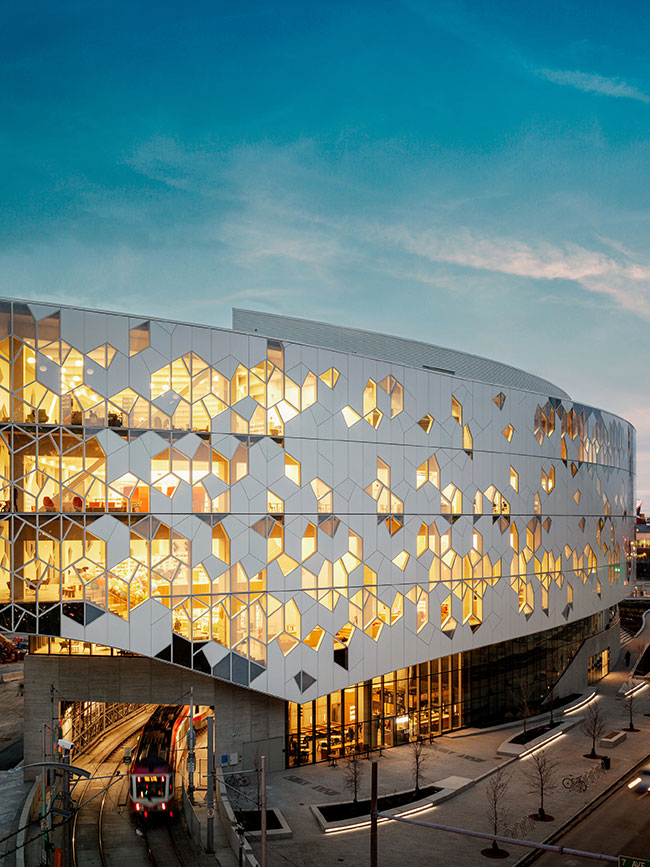
Features
Architectural design
Innovations
Whole carbon
New approaches are needed to address embodied carbon in our materials.
October 26, 2023 By Treena Hein
 The Calgary Central Library,
featured in our 2019 Great
Glazing issue, used Vitro
low-carbon glass. In the years ahead, we’ll be under pressure to reduce the carbon impact of glass and aluminum on projects.
The Calgary Central Library,
featured in our 2019 Great
Glazing issue, used Vitro
low-carbon glass. In the years ahead, we’ll be under pressure to reduce the carbon impact of glass and aluminum on projects. Greening the Canadian fenestration industry is no different than greening any other. It’s about taking a myriad of approaches: collaboration, research, picking the low-hanging fruit first and working steadily on other areas that are more challenging. In the years to come, it will mean sourcing materials with the lowest embodied carbon (EC, emissions caused by manufacturing and installation) even as we continue the fight to lower operational carbon (OC, emissions from individual company processes). Manufacturers can use a variety of tactics, including using non-emitting energy sources, electrifying their vehicles (as long as the electricity source is green), and reshoring supplies to reduce the embodied carbon of their products. All of it will come into the calculations architects and, soon, governments will use to assess whether our products are as sustainable as they want.
But all this must be achievable at a price companies can afford. So, while Terry Adamson, technical director at Fenestration Canada, believes sourcing lower EC materials will gain traction as the EC discussion picks up and it’s inserted into building codes, he “would think today there are only a handful of manufacturers that are actively sourcing these [low-carbon]materials. I would think the cost would be prohibitive in today’s already challenging cost-soaring materials supply chain.”
SAWDAC technical director, Phil Lewin, has similar thoughts. “If there is a way to lower carbon emissions during any stage of manufacture, from sub-components to final products, it should be pursued,” he says. “If it’s ecologically effective but not cost-effective, that would need to be addressed with government involvement.”
Adamson says he has not had any member inquiries about where to find lower EC materials for fenestration manufacturing. His focus is on letting members know what EC is and that they should start thinking about what it means to their businesses. “I have a session scheduled at WinDoor that will dive into this,” he reports.
Product lifetime
An aspect of the industry that should be at the very centre of the environmental impact discussion but for whatever reason has largely been ignored is product durability. That’s the view of Mike Battistel, president and co-founder of Cascadia in Langley, B.C.. Lewin agrees that greater product longevity is critical for not incurring new production carbon emissions prematurely.
Battistel reports, “Right now, we’re replacing windows manufactured by others that are only 25 to 30 years old. And the amount of energy that’s used in actually carrying out a retrofit is much more than producing the windows themselves. Think about all the people working on a project driving back and forth to their homes, the caulking, the exterior and interior finishes. There’s so much work and emissions involved. So if you have a product that can last 50 to 60 years instead of half that [which Cascadia offers – see profile in this issue], that’s a colossal reduction in environment impact.”
Battistel would like to see durability included in building codes, and if LEED or other organizations could mandate higher standards for lifespan that would also be helpful. In its “BD Plus C: New Construction version 4.1,” LEED lists two ways to attain points as it attempts “to reward project teams for selecting products verified to have been extracted or sourced in a responsible manner.” Both ways to attain points relate to products sourced from multiple manufacturers that meet at least one of LEED’s responsible sourcing and extraction criteria and amount to minimum percentages of the total value of a project’s permanently-installed products.
It’s expected that, in the future, building contractors will have to provide life cycle information showing the contribution of each building product to a building’s total carbon footprint. This can only strongly promote the use of materials made in North America such as Canadian aluminum. It’s carbon footprint is much lower than that of Chinese aluminum not just due to no transoceanic shipping but due to the sole use of hydro-generated electricity instead of coal-generated.
Hydro is a Norwegian company advertising low-carbon aluminum. It claims its Circal product uses 75 percent recycled post-consumer aluminum, delivering a final carbon footprint under 2.3 kilograms of carbon dioxide per kilogram of product. Its Reduxa product uses renewable energy sources for aluminum smelting to attain under four kilograms carbon dioxide per kilogram of aluminum.
Of course, glass products higher in efficiency and with lower EC are of interest as well.

Greener glass
Looking at new, more-efficient products, in June Corning announced it’s about to market thin-triple IGUs that will meet Energy Star 7.0 requirements, which are set to take effect in October 2023. These IGUs are of course lighter and less bulky compared to standard triple-pane IGUs. They’ll have a new 0.5-millimeter glass for their inner lites (one-sixth normal thickness) with a thermal expansion one-third of what’s found in traditional soda glass. Corning stated that this product will help set companies up to achieve a U-factor of up to 0.17, with room-side low-E coatings not required. The price is just above that of double-pane IGUs.
Having windows containing recycled glass would also be a very positive step for industry. Consumer glass recycling is of course widespread in North America, but whether any window glass is currently recycled is hard to discern. In the U.K., however, glass manufacturer Saint-Gobain already uses recycled glass and recently committed to increasing use of glass pieces (called cullet) to 50 percent of its production by 2025. Some in the industry also report there are companies here in North America looking at how to recycle all window components.
Lowering embodied carbon through greener manufacturing is something global glass manufacturer Vitro is working on for all its glass products made across all its many plants. Vitro Canada has fabrication plants in Barrie Ont., Calgary Alta., Bedford N.S and Winnipeg.
In June, Vitro Architectural Glass published updated versions of its Environmental Product Declarations for both flat and processed glass. EPDs are a standard measure of EC measured in a global warming potential value expressed as kilograms of carbon dioxide equivalent. “In 2017, we became the first North American glass manufacturer to publish third-party-verified EPDs,” explains Michael Hammond, technical services manager at Vitro Architectural Glass. “Our latest EPDs indicate that our products contain just 1,350 kilograms of carbon dioxide equivalent, six percent lower than the National Glass Association’s industry-standard figure, and an improvement on our 2017 figures.”
To complete these updated EPDs, Vitro selected a leading consulting firm then established the timeframe. Hammond explains that EPDs require submitting at least 12 months’ worth of data, but with the impact of the pandemic, they decided to supply 24 months’ worth of data from 2018 and 2019 to ensure more sound results.
Next came data collection. “Many facts and figures factor into the life cycle assessment, including raw material usage, utility usage (both gas and electricity) and packaging and production information,” says Hammond. “From there, the program operator and LCA practitioner develop the model and calculate our products’ GWP. This information was then submitted to a third party for review and validation.”
As to whether EPDs should be standard for all glass companies, Hammond notes that with current, pending and proposed Buy Clean requirements in the U.S., EPDs are no longer the exception but the rule. However, he recognizes they are costly to produce, validate and publish, and require a considerable time commitment as well.
Glass manufacture
Using hydrogen or renewable biofuels will hopefully someday be widely available to power glass manufacture. Large amounts of intense heat are obviously required. David Heska, director of Southwestern Ontario Building Sciences (a part of global engineering firm WSP which completes projects from window replacements to new window and curtainwall builds), notes that the source of electricity used along the way is also a significant environment impact factor, and more carbon-free electricity production is certainly needed.
At Vitro, the production teams have lowered EC during glass production in several proprietary ways. These include more efficient use of batch material and implementing furnace efficiency and design improvements.
In addition, Vitro has a patented oxy-fuel furnace technology that melts raw materials such as sand and silica through mixing oxygen (instead of air) with natural gas. This system reduces energy consumption in glass-melting furnaces by as much as 20 percent, says Hammond, and cuts greenhouse gas emissions in half. Vitro has also worked on equipment regulation and driving improvements in their supply chain.
Lastly, carbon capture and storage is also being explored in the fenestration industry, at least in Europe. U.K.-based C-Capture is currently assessing the feasibility of using its technology with Pilkington Glass.
Major suppliers to the glass industry have obviously taken note and are working to make the materials available that might satisfy demands for lower carbon building facades in the future. But much needs to be done and, as noted above, prices will need to be brought into line. An opportunity exists for Canadian industry to gain an advantage with locally sourced materials and component production. But at least for now it’s hard to see how architectural glass designs will be able to meet the net-zero criteria for whole-life carbon that some governments and activists talk about. •
Print this page
Leave a Reply